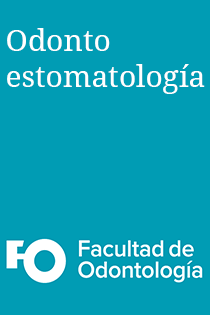Abstract
Objectives: Describe the pattern of variation in the shape of the mandibular dental arch in a sample of the Metropolitan Region through an observational, cross-sectional study. Methods: 18 landmarks on 134 standardized photographs of dental casts were digitized and a Procrustes analysis was performed. Results: The size of the centroid in men is significantly larger than in women. Discriminant analysis with gender cross-validation did not show significant differences in the shape components. The pattern of variation in the shape of the dental arches is mainly explained by PC1 (50.1% of the total variation, anteroposterior variation) and PC2 (13.3%, transverse variation). Conclusions: Given the morphological continuity that is observed when performing a statistical analysis of the pattern of variation in shape and size of the arch applying geometric morphometric tools, the use of preformed templates for determining the shape of the dental arch should be reconsidered.
References
Proffit. Equilibrium theory revisited: factors influencing position of the teeth. Angle Orthod. 1978 Jul; 48(3):175-86.
Juárez, Venegas. Prevalencia de la forma de los arcos dentales en adultos con maloclusión y sin tratamiento ortodóncico. Revista odontológica mexicana, 2006 vol. 10 Núm. 3 pp109-114.
O`Neil, Kau. Comparison of dental arch forms created from assessment of teeth, alveolar bone, and the overlying soft tissue. J orofac orthop, 2021 82: 413-421.
Yang, Li. Comparison of maxillary anterior mathematical proportions among 3 dental arch form. The journal of prosthetic dentistry, 2021.
Banabilh, Suzina, Dinsuhaimi, Samsudin, Singh. Dental arch morphology in south-east Asian adults with obstructive sleep apnoea: geometric morphometric. Journal of oral rehabilitation, 2009 36; 184- 192.
Rainly. Craniofacial Growth, Dent Clin North Am. 2000, Jul; 44 (3):457-70.
Agurto, Sandoval. Morfología del arco maxilar y mandibular en niños de ascendencia mapuche y no mapuche. Int. J. Morphol, 2011 29(4):1104-1108.
Nojima, Mclaughlin, Isshiki & Sinclair. A comparative study of Caucasian and Japanese mandibular clinical arch forms. Angle Orthodontist, vol. 71, No. 3, 2001.
Bedoya, Osorio & Tamayo. Dental ach size, biting force, bizygomatic width and face height in three Colombian ethnic groups. Int. J. Morphol, 2015 33(1): 55-61.
Camporesi, Franchi, Baccetti & Antonini. Thin plate spline analysis of arch form in a southern European population with an ideal natural occlusion. European journal of orthodontics, 2006 135-140.
Wang, Xia, Jiayi Li, Lvyuan Li, Fei Yu, Yuan, Fang &Ye. Accuracy of dental arch form in customized fixed labial orthodontic appliances. AJO-DO, 2022 (162(2): 173-181.
Wen, Hai Ming Wong, Tao Pei & Mcgrath. Adolescent dental arch development among southern Chinese in Hong Kong: a geometric morphometric approach. Nature research, 2019 9:18526.
Singh, McNamara & Lozanoff. Spline analysis of the mandible in human subjects with Class III malocclusion. Archives of Oral Biology, 1997 42(5), 345-353.
Chang, Lin, Liu & Chang. Midfacial and mandibular morphometry of children with Class II and Class III malocclusions. Journal of Oral Rehabilitation, 2005 32(9), 642-647.
Franchi, Baccetti, Stahl & McNamara. Thin-plate Spline Analysis of Craniofacial Growth in Class I and Class II Subjects. The Angle Orthodontist, 2007 77(4), 595-601.
Díaz Muñoz & Manríquez Soto. Skeletodental Diagnosis Using a Geometric Morphometric Approach. International Journal of Odontostomatology, 2014 8(1), 05-11.
Rohlf. Morphometrics. Annu. Rev. Ecol. Syst. 1990. 21: 299-316
Slice. Geometric Morphometrics. Annual Review of Anthropology, 2007 36(1), 261-281.
Toro Ibacache, Manríquez Soto & Suazo Galdames. Morfometría Geométrica y el Estudio de las Formas Biológicas: De la Morfología Descriptiva a la Morfología Cuantitativa. International Journal of Morphology, 2010 28(4), 977-990.
Adams, & Otárola-Castillo. geomorph: An r package for the collection and analysis of geometric morphometric shape data. Methods in Ecology and Evolution, 2013 4(4), 393-399.
Benítez & Püschel. Modelando la Varianza de la Forma: Morfometría Geométrica Aplicaciones en Biología Evolutiva. International Journal of Morphology, 2014 32(3), 998-1008.
Mitteroecker & Schaefer. Thirty years of geometric morphometrics: Achievements, challenges, and the ongoing quest for biological meaningfulness. American Journal of Biological Anthropology, 2022 178(S74), 181-210.
Adams, Rohlf & Slice. A field comes of age: Geometric morphometrics in the 21st century. Hystrix, the Italian Journal of Mammalogy, 2013 24(1).
Little. The Irregularity Index: A quantitative score of mandibular anterior alignment. Am. J. of Orthod. Vol. 68 num. 5. 554- 56
Brace & Ryan. Sexual dimorphism and human tooth size differences. Journal of Human Evolution, 1980 9(5), 417-435.
Guatelli-Steinberg, Sciulli & Betsinger. Dental crown size and sex hormone concentrations: Another look at the development of sexual dimorphism. American Journal of Physical Anthropology, 2008 137(3), 324-333.
Hattab, Al-Khateeb & Sultan. Mesiodistal crown diameters of permanent teeth in jordanians. Archives of Oral Biology, 1996 41(7), 641-645.
Shaweesh. Mesiodistal and faciolingual diameters of the permanent teeth in a Jordanian population. Archives of Oral Biology, 2017 73, 253-258.
Papagiannis & Halazonetis. Shape variation and covariation of upper and lower dental arches of an orthodontic population. The European Journal of Orthodontics, 2016 38(2), 202-211.
Agurto & Sandoval. Morfología del Arco Maxilar y Mandibular en Niños de Ascendencia Mapuche y no Mapuche. International Journal of Morphology, 2011 29(4), 1104-1108.
Lombardo, Fattori, Molinari, Mirabella, Siciliani. Dental and alveolar arch forms in a Caucasian population compared with commercially available archwires. International Orthodontics, 2013; 11: 389- 421.
Tajik, Mushtaq, Khan. Arch forms among different angle classifications a – study. Pakistan Oral & Dental Journal Vol 31, No. 1 (June 2011.
Paranhos, Andrews, Jóias, Bérzin, Daruge, Triviño. Dental arch morphology in normal occlusions. Braz J Oral Sci. 10(1):65-68.
Rossouw & Malik. The retention protocol. In Seminars in Orthodontics. 2017 23 (2), 237-248.

This work is licensed under a Creative Commons Attribution-NonCommercial 4.0 International License.


